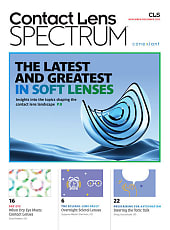We live during a time when practically every person is susceptible to dry eye disease (DED). Excessive screen time is increasingly recognized as a leading etiologic driver.1 Left untreated, DED can negatively affect patient productivity and quality of life; cause contact lens dropout2; derail cataract and refractive surgery outcomes3; and preclude glaucoma treatment success.4 From a practice management standpoint, all these deleterious consequences can prompt patients to seek a new eyecare provider if their DED is not recognized and managed appropriately.
Now, that I’ve explained why diagnosing DED should be a priority, here, I discuss the available DED diagnostics, organized by traditional and modern (point-of-care) methods. Traditional methods remain foundational, with point-of-care technologies offering enhanced precision and objective data that strengthen the diagnostic process. By combining both approaches, clinicians can more accurately diagnose and manage DED, improving outcomes and patient satisfaction.

Traditional Methods
The traditional diagnostic methods are comprised of symptom-based assessments and basic in-office tests that aid in identifying the clinical signs of DED. These methods:
• DED questionnaires. Patient questionnaires, such as the Dry Eye Questionnaire-5, Impact of Dry Eye in Everyday Life, Ocular Surface Disease Index-6 (recently recommended by the Tear Film & Ocular Surface Society [TFOS] Dry Eye Workshop [DEWS] III report), the Standardized Patient Evaluation of Eye Dryness, and the Symptom Assessment in Dry Eye questionnaires, have been used to determine whether patients have DED symptoms that require further investigation.5
• Vital dyes. Employing the vital dyes sodium fluorescein (NaFl) and lissamine green (LG) highlight abnormalities in the cornea, conjunctiva, and lid margin that can point to a diagnosis of DED. Lid wiper epitheliopathy is a common clinical finding in DED patients that can only be visualized with vital dyes.6 Also, vital dyes can aid in the identification of DED masqueraders and co-conspirators, such as anterior basement membrane dystrophy, conjunctivochalasis, and neurotrophic keratitis (NK).7
• Tear break-up time (TBUT) assessment.
Assessing tear break-up time allows for measuring tear film stability. To perform this assessment, the optometrist administers a saline-moistened NaFl strip into the inferior cul-de-sac. A TBUT below 10 seconds indicates instability, which is a hallmark of DED.
Understanding DED
DED is broadly classified into aqueous-deficient and evaporative subtypes, although a mixed mechanism is commonly observed.5 Aqueous-deficient DED results from inadequate tear production, often linked to lacrimal gland dysfunction, while evaporative DED is commonly associated with meibomian gland dysfunction, which leads to increased tear evaporation. The TFOS DEWS III defines DED as “a multifactorial, symptomatic disease characterized by a loss of homeostasis of the tear film and/or ocular surface, in which tear film instability and hyperosmolarity, ocular surface inflammation and damage, and neurosensory abnormalities are etiological factors.”
Signs and symptoms in DED often show poor correlation,7 which can make diagnosis and management challenging. A patient can have severe symptoms with minimal clinical signs, or clear signs with little to no reported discomfort. The presence of neurosensory abnormalities and/or patient adaptation to long-standing disease are thought to contribute to this disparity.
• Schirmer’s test. This test shows basal and reflex tear production. To carry out the Schirmer’s test, the OD instills numbing drops (to evaluate basal tearing) before inserting a folded paper strip into the lower lids and instructing the patient to close their eyes for about 5 minutes. After this time, the optometrist measures the strip for tears. Values <5 mm in 5 minutes suggest aqueous-deficient DED. The nonanesthetized version simultaneously assesses basal tear production and trigeminal reflex tearing triggered by eye irritation from the filter paper.8 A low Schirmer’s test score may prompt consideration of specific treatment modalities, including topical autologous serum and platelet-rich plasma drops.9
• Phenol red thread test. An alternative to Schirmer’s test, this measures tear production using a pH-sensitive thread placed in the lower eyelid for 15 seconds. The thread changes color in response to tears, and the length of the red-stained portion indicates tear volume.10
• Manual meibomian gland evaluation. This is done to assess the secretion quality of the meibomian glands at the slit lamp. The OD can accomplish this by manually pressing the glands with their thumb/finger, a cotton tip applicator, a paddle, or a tool applied to the lower lid. Unhealthy secretion can appear as cloudy, white, or yellow, or it can have a toothpaste-like consistency. All are indicative of meibomian gland dysfunction (MGD), the leading cause of evaporative DED.11
• Eyelid evaluation. This is a physical examination to identify common entities, such as Demodex blepharitis, ocular rosacea, lagophthalmos, lid laxity, and incomplete blinking.
• Corneal sensitivity testing. Reduced corneal sensation indicates nerve dysfunction, which may lead to NK. A cotton wisp is lightly pressed on the cornea to elicit a blink or slight irritation, indicating an intact ophthalmic nerve branch.12
Modern Methods
These diagnostic tools can complement the traditional diagnostic tests, as they offer objective and reproducible measures that aid in the identification of DED.
• Matrix metalloproteinase-9 (MMP-9) test. This detects this biomarker for ocular surface inflammation. Elevated MMP-9 levels are often found in moderate to severe DED patients, as well as in other common conditions, such as allergic con-
junctivitis, conjunctivochalasis, and floppy eye-
lid syndrome.13,14 Identifying elevated levels of MMP-9 facilitates better management of DED patients. For example, MMP-9 positive DED patients may respond more favorably to an immunomodulator than MMP-9 negative patients.15
• Tear osmolarity testing. This testing, available in 2 separate devices, measures the amount of salt in tears. High values of salt or an elevated inter-eye difference indicate hyperosmolarity and tear film instability. As an objective test, tear osmolarity provides a precise, numerical value, is highly sensitive and specific for DED,16 and is often elevated prior to the presence of visible signs, such as vital dye staining.17 I have found it imperative to identify hyperosmolarity prior to cataract or refractive surgery, as this typically needs to be addressed to minimize the risk of a “20/Unhappy” patient postoperatively.18
• Meibographer. This instrument, available from several different manufacturers, enables visualization of the structure of the meibomian glands to aid in the diagnosis of MGD. It is important to remember that both structure and function of the meibomian glands need to be assessed to determine disease severity, prognosis, and appropriate treatment recommendations.
• Noninvasive TBUT and lipid layer analysis (interferometry). Available from an array of manufacturers, the noninvasive TBUT test provides accurate, repeatable measurements without disrupting the tear film. This leads to a more reliable assessment. Lipid layer analysis complements this by aiding in the evaluation of the quality and stability of the tear film’s outermost layer, which is essential for preventing tear evaporation. Together, these tests enable early detection of tear film irregularity.
• Tear meniscus height measurement. This test provides an automated assessment of tear meniscus height. A low height signifies inadequate tear production, which indicates aqueous-deficient DED.
• Blink analysis. Poor blink dynamics are common in DED patients.19 Automated blink analysis eliminates subjectivity by providing consistent and measurable metrics on blink patterns (eg, blink rate, completeness, and interblink interval). Automated blink analysis also helps detect subtle abnormalities, including incomplete blinking associated with MGD,20 that may be missed during manual observation.
• Bulbar redness. Automated assessment of conjunctival hyperemia is another tool that can be used to document severity and track improvements with therapy. Modern devices use high-resolution imaging and automated grading systems to objectively quantify redness levels, eliminating the subjectivity of traditional visual assessments.
• Anterior-segment ocular coherence tomography (AS-OCT). Noninvasive measurement of tear meniscus height and tear volume can be obtained via OCT, although clinical utility is unclear.21
• Corneal topography. DED may cause an increase in higher-order aberrations that can be detected by topography.22 It is particularly valuable in detecting subclinical DED before refractive or cataract surgery.34
Future Directions
Emerging trends in DED diagnostics include the integration of artificial intelligence for image analysis and DED diagnosis.25 Additionally, the development of at-home monitoring tools, including wearable sensors26 and smartphone-based platforms,27 may enable real-time tracking of symptoms and tear film parameters. Further, advances in biomarker research may lead to the identification of novel targets for both DED diagnosis and therapy. In closing, there is much to look forward to in the realm of DED diagnostics, including our ability to accurately diagnose and treat those affected by DED: practically every patient. OM
References
1. Fjaervoll K, Fjaervoll H, Magno M, et al. Review on the possible pathophysiological mechanisms underlying visual display terminal-associated dry eye disease. Acta Ophthalmol. 2022;100(8):861-877. doi:10.1111/aos.15150.
2. Gomes JAP, Azar DT, Baudouin C, et al. TFOS DEWS II iatrogenic report. Ocul Surf. 2017;15(3):511-538. doi:10.1016/j.jtos.2017.05.004
3. De Gregorio C, Nunziata S, Spelta S, et al. Unhappy 20/20: A New Challenge for Cataract Surgery. J Clin Med. 2025;14(5):1408. Published 2025 Feb 20. doi:10.3390/jcm14051408.
4. Nijm LM, Schweitzer J, Gould Blackmore J. Glaucoma and Dry Eye Disease: Opportunity to Assess and Treat. Clin Ophthalmol. 2023;17:3063-3076. Published 2023 Oct 17. doi:10.2147/OPTH.S420932.
5. Fjaervoll K, Fjaervoll H, Magno M, et al. Review on the possible pathophysiological mechanisms underlying visual display terminal-associated dry eye disease. Acta Ophthalmol. 2022;100(8):861-877. doi:10.1111/aos.15150.
6. Wolffsohn JS, Benítez-Del-Castillo J, Loya-Garcia D, et al. TFOS DEWS III Diagnostic Methodology. Am J Ophthalmol. Published online May 30, 2025. doi:10.1016/j.ajo.2025.05.033.
7. Korb DR, Herman JP, Greiner JV, et al. Lid wiper epitheliopathy and dry eye symptoms. Eye Contact Lens. 2005;31(1):2-8. doi:10.1097/01.icl.0000140910.03095.fa.
8. Brissette AR, Drinkwater OJ, Bohm KJ, Starr CE. The utility of a normal tear osmolarity test in patients presenting with dry eye disease like symptoms: A prospective analysis. Cont Lens Anterior Eye. 2019;42(2):185-189. doi:10.1016/j.clae.2018.09.002.
9. Brott NR, Zeppieri M, Ronquillo Y. Schirmer Test. [Updated 2024 Feb 24]. In: StatPearls [Internet]. Treasure Island (FL): StatPearls Publishing; 2025 Jan.
10. Kang MJ, Lee JH, Hwang J, Chung SH. Efficacy and safety of platelet-rich plasma and autologous-serum eye drops for dry eye in primary Sjögren's syndrome: a randomized trial. Sci Rep. 2023;13(1):19279. Published 2023 Nov 7. doi:10.1038/s41598-023-46671-2.
11. Vashisht S, Singh S. Evaluation of Phenol Red Thread test versus Schirmer test in dry eyes: A comparative study. Int J Appl Basic Med Res. 2011;1(1):40-42. doi:10.4103/2229-516X.81979.
12. Sheppard JD, Nichols KK. Dry Eye Disease Associated with Meibomian Gland Dysfunction: Focus on Tear Film Characteristics and the Therapeutic Landscape. Ophthalmol Ther. 2023;12(3):1397-1418. doi:10.1007/s40123-023-00669-1.
13. Khan ZA. Revisiting the Corneal and Blink Reflexes for Primary and Secondary Trigeminal Facial Pain Differentiation. Pain Res Manag. 2021;2021:6664736. Published 2021 Feb 9. doi:10.1155/2021/6664736.
14. Acera A, Rocha G, Vecino E, Lema I, Durán JA. Inflammatory markers in the tears of patients with ocular surface disease. Ophthalmic Res. 2008;40(6):315-321. doi:10.1159/000150445.
15. Sward M, Kirk C, Kumar S, Nasir N, Adams W, Bouchard C. Lax eyelid syndrome (LES), obstructive sleep apnea (OSA), and ocular surface inflammation. Ocul Surf. 2018;16(3):331-336. doi:10.1016/j.jtos.2018.04.003.
16. Park JY, Kim BG, Kim JS, Hwang JH. Matrix Metalloproteinase 9 Point-of-Care Immunoassay Result Predicts Response to Topical Cyclosporine Treatment in Dry Eye Disease. Transl Vis Sci Technol. 2018;7(5):31. Published 2018 Oct 29. doi:10.1167/tvst.7.5.31.
17. Lemp MA, Bron AJ, Baudouin C, et al. Tear osmolarity in the diagnosis and management of dry eye disease. Am J Ophthalmol. 2011;151(5):792-798.e1. doi:10.1016/j.ajo.2010.10.032.
18. Liu H, Begley C, Chen M, et al. A link between tear instability and hyperosmolarity in dry eye. Invest Ophthalmol Vis Sci. 2009;50(8):3671-3679. doi:10.1167/iovs.08-2689.
19. Sullivan BD, Palazón de la Torre M, Yago I, et al. Tear Film Hyperosmolarity is Associated with Increased Variation of Light Scatter Following Cataract Surgery. Clin Ophthalmol. 2024;18:2419-2426. Published 2024 Aug 28. doi:10.2147/OPTH.S484840.
20. Su Y, Liang Q, Su G, Wang N, Baudouin C, Labbé A. Spontaneous Eye Blink Patterns in Dry Eye: Clinical Correlations. Invest Ophthalmol Vis Sci. 2018;59(12):5149-5156. doi:10.1167/iovs.18-24690.
21. Jie Y, Sella R, Feng J, Gomez ML, Afshari NA. Evaluation of incomplete blinking as a measurement of dry eye disease. Ocul Surf. 2019;17(3):440-446. doi:10.1016/j.jtos.2019.05.007.
22. Diana MP, Ana B. Tear evaluation by anterior segment OCT in dry eye disease. Rom J Ophthalmol. 2021;65(1):25-30. doi:10.22336/rjo.2021.6.
23. Kasem, Ahmed M. M.a,; Awara, Amr M.b; Shafik, Heba M.b; Shalaby, Osama E.b. Corneal topography and wavefront data changes in dry eye. Tanta Medical Journal 49(1):p 31-36.
24. Nilsen C, Gundersen M, Graae Jensen P, et al. The Significance of Dry Eye Signs on Preoperative Keratometry Measurements in Patients Scheduled for Cataract Surgery. Clin Ophthalmol. 2024;18:151-161. Published 2024 Jan 16. doi:10.2147/OPTH.S448168.
25. Heidari Z, Hashemi H, Sotude D, et al. Applications of Artificial Intelligence in Diagnosis of Dry Eye Disease: A Systematic Review and Meta-Analysis. Cornea. 2024;43(10):1310-1318. doi:10.1097/ICO.0000000000003626.
26. Rajan A, Vishnu J, Shankar B. Tear-Based Ocular Wearable Biosensors for Human Health Monitoring. Biosensors (Basel). 2024;14(10):483. Published 2024 Oct 8. doi:10.3390/bios14100483.
27. Nagino K, Okumura Y, Yamaguchi M, et al. Diagnostic Ability of a Smartphone App for Dry Eye Disease: Protocol for a Multicenter, Open-Label, Prospective, and Cross-sectional Study. JMIR Res Protoc. 2023;12:e45218. Published 2023 Mar 13. doi:10.2196/45218.




